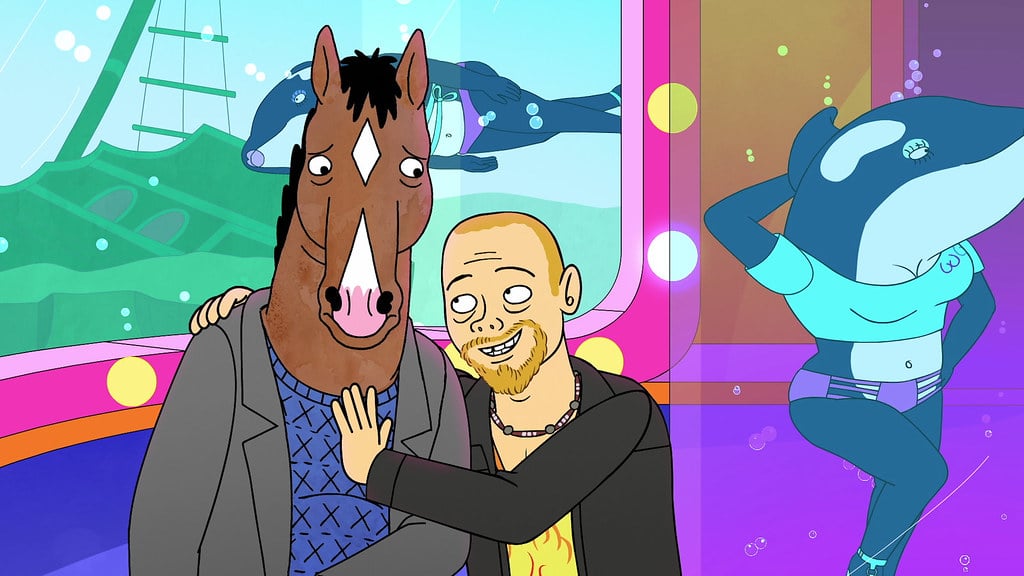We’ve all, I’m sure, spent time scrolling listlessly through Netflix, trying to find something to watch: sometimes succeeding, sometimes not. This was when I first stumbled across Bojack Horseman. The colourful thumbnail, showing a smiling horse, seemed to suggest I had stumbled across the children’s section, or that my brother had, once again, been using my account. But the adult age restriction suggested otherwise.
The show, which premiered in 2014, was already in its third series by the time I started watching it. I sped through the first few episodes, drawn in by the quick pacing, catchy character design, and the question of why these talking animals were coexisting with humans, no questions asked.
Whilst initially receiving mixed reviews, with the first series having a 70% rating on Rotten Tomatoes, the following series received scores in the high 90s, with series 2 and 3 receiving scores of 100%. Evidently there is some appeal to this tragicomic series, but how much is tied up to its cartoon form?
It is the absurdity of the cartoon form, in its sometimes weird and wonderful approach to life, that I believe facilitates its appeal. We’re all introduced to cartoons as children, and it is the form’s bright, nonsensical attitude towards storytelling that appeals to children, with one BBC article examining the impact of the ‘attention-grabbing features’ such as ‘colour, brightness and movement’ on the ‘primitive visual system’ of children. Furthermore, the same article highlights how children ‘process information’ differently to us, leading to our perception of what may be ‘highly engaging’ for them, to be ‘weird’ for us.
But this still doesn’t explain the enduring appeal of animation for adults. Perhaps it’s nostalgia, our sense of longing for a simpler time, when all the problems of the world could be solved within the confines of a thirty-minute time slot. But with adult cartoons such as Big Mouth, a show which revels in discomfort and awkwardness, the focus seems to be on a perversion of our expectations of the genre. Like puberty, Big Mouth is unexpected, shocking, and sometimes downright dirty, and scenes such as the one where Jay impregnates a pillow seem less nostalgic than just pure weird — even absurd.
With the host of adult animation on streaming services, the demand is evident. I propose that we start considering animation as the art form it is: one that allows for the pushing of boundaries and the creation of beautiful nonsense. There’s something quite lovely about the way that Big Mouth, for example, conceptualises the ‘hormone monsters’, using them to personify all the weirdness of puberty. Yet, the whole concept would not have worked within a regular sitcom format, with real actors and a reliance on CGI or costumes creating a weird divide between the real and the fantasy. The brilliance of shows like Big Mouth is that creatures such as the hormone monsters are as concrete within the show as any other character, their absurdity integrated into the show’s very fabric.
In Bojack Horseman, reality is similarly forsaken, with the art form of animation pushed to its limit; whilst most episodes follow Bojack’s life, others are complete abstractions of reality, following a drug binge, for example. My favourite episode is in a similar vein, following the character of Diane and her struggles with depression. The episode diverts from the usual animation style, using black and white line drawings, with squiggles and crossings-out, to mirror Diane’s mental state. This change in art-style resonated with my own struggles with depression and taking antidepressants far more than any other television show. Diane’s depression becomes part of the animation style itself, her whole worldview reduced to black and white drawings which, even then, seem out of her control. It was a refreshing take on mental illness, something so often romanticised within the media; just picture the countless TV shows or films which show beautiful women crying under duvet covers. I can say with certainty that I have never looked that beautiful or made-up during the throes of a depressive episode.
There’s a certain fluidity to animation too. Diane’s character, as a result of her depression, puts on weight, but this is something that is never commented on. With a traditional show format, an actress would have to don a fat suit (something which feels more mocking than sympathetic to real struggles) or would have to make constant comments about her weight à la Bridget Jones, who was, if anything, skinnier than the average woman. The way that Diane’s weight gain and depression is presented is beautiful; her weight gain is a part of the essence of her character, a simple fact that is never remedied or drawn attention to in an overt way.
Bojack Horseman’s animation allows its initial relative innocence (look, it’s a talking horse!) to lead to an exploration of much darker themes. Although in episode one Bojack says that all anyone wants in life is to “watch a show about good, likeable people who love each other”, the art of animation provides room for much, much more.
Image credit: Festival Annecy / Mike Hollingsworth via Flickr (CC BY-NC-ND 2.0).



